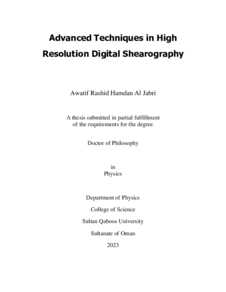وثيقة
Advanced techniques in high resolution digital shearography.
المصدر
Doctoral dissertation
عناوين أخرى
تقنيات متطوره في التصوير الاشعاعي الرقمي
الدولة
Oman
مكان النشر
Muscat
الناشر
Sultan Qaboos University
ميلادي
2023
اللغة
الأنجليزية
نوع الرسالة الجامعية
Doctoral dissertation
الملخص الإنجليزي
Digital phase-stepping (phase-shifting) shearography is a modern technique for
measuring microscopic displacement gradients of an object surface by interferometric
speckle techniques. The phase map of the displacement derivatives of a strained object
was generated using laser speckles in this technique. As a result, the stresses of a
deformed object could be directly mapped. Phase-stepping shearography is also very
useful in industrial non-destructive testing (NDT). In conventional digital phasestepping shearography, a video camera of relatively limited resolution is used for
imaging the laser speckles. The maximum resolution of the video camera is only of the
order of 5 Megapixels. These limits the spatial resolution for the generated shearograms
and phase maps, and consequently, limits the maximum value of the deformations that
could be successfully observed in a given situation. We improved the shearography
technique and, in particular, performed advanced shearographic experiments with
substantially higher spatial resolution than is now achievable. This unique technique
used a Michelson-type shearing setup with an edge-clamped, center-loaded plate and a
24-megapixel still digital imaging device (DSLR camera). Various phase-stepping
algorithms were tested, and they all generated shearograms of acceptable quality. This
effectively increased the useful spatial resolution of phase-stepping shearography by
roughly 5 times compared to the conventional method using video-rate cameras, and
would also improve spatial resolution in possible NDT applications. We also
investigated the relevance of the Nyquist criterion in digital shearography. We
investigated its significance and applicability in phase- stepping digital shearography,
which had been developed into a useful technique for creating displacement gradient
maps of extended objects. We demonstrated that it is not required to fully adhere to the
Nyquist criterion in digital shearography using quantitative and experimental data that
were obtained from our research projects. Operating the digital image device in the subNyquist domain (down to an N-parameter of 1.9) was both possible and desirable. This
vi
will offer suggestions to the shearography experimenter for the best methods to carry
out image sampling in the case of digital shearography.
Because the laser is an important element in the shearography experiment, we
conducted experiments on the power stability of the laser. We examined the effect and
influence of power stability of different commonly used lasers on the results of phasestepping shearographic experiments. With three distinct lasers (a helium-neon laser, a
red diode laser, and a green frequency-doubled neodymium laser), we measured the
power stability. We discovered a connection between the shearogram quality and the
laser power stability. The results obtained in these experiments could make it possible
to select the laser that will produce shearograms of the highest quality, with the greatest contrast and the least amount of noise. To the best of our knowledge, these types of experiments have never been carried out previously.
الملخص العربي
التصوير القصي الاشعاعي المرحلي للطور(تحويل الطور) هو تقنية حديثة لقياس تدرجات الازاحة المجهرية لسطح الجسم بواسطة تقنيات البقع التداخلية. تم إنشاء خريطة الطور لمشتقات الازاحة لجسم متوتر رش باستخدام بقع الليزر في هذه التقنية. ونتيجة لذلك، يمكن تعيين ضغوط الجسم المشوه مباشرة كما أن التصوير القصي المرحلي مفيد جدا في الاختبارات الصناعية غير المد مرة (NDT) في القصي بالمرحلة الاشعاعية
قالب العنصر
الرسائل والأطروحات الجامعية

